Cheonggyecheon
| Cheonggye (청계천) | |
| River | |
 Mojeon Bridge crossing Cheonggyecheon (2012) | |
| Country | South Korea |
|---|---|
| Provinces | Seoul |
| Tributaries | |
| - left | Seongbukcheon, Jeongneungcheon |
| Source | Suseongdong Valley in Mount Inwang |
| - location | Ogin, Jongno, Seoul |
| Mouth | Jungnangcheon |
| - location | Yongdap, Seongdong, Seoul |
| Length | 10.92 km (7 mi) [1] |
| Basin | 50.96 km2 (20 sq mi) [1] |
| Cheonggyecheon | |
| Hangul | 청계천 |
|---|---|
| Hanja | 淸溪川 |
| Revised Romanization | Cheonggyecheon |
| McCune–Reischauer | Ch'ŏnggyech'ŏn |
Cheonggyecheon (Hangul: 청계천) is a 10.9 km (7.0 miles) long, modern public recreation space in downtown Seoul, South Korea. The massive urban renewal project is on the site of a stream that flowed before the rapid post-war economic development caused it to be covered by transportation infrastructure. The $900 million project initially attracted much public criticism but, after opening in 2005, has become popular among residents and tourists.
Geography
Cheonggyecheon is an 8.4 km creek flowing west to east through downtown Seoul, and then meeting Jungnangcheon, which connects to the Han River and empties into the Yellow Sea. During the presidency of Park Chung-hee, Cheonggyecheon was covered with concrete for roads. In 1968, an elevated highway was built over it.
History
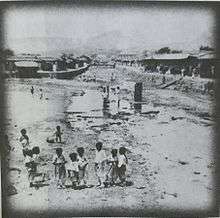
The stream was named Gaecheon ("open stream") after the first refurbishment project to construct a drainage system during the Joseon Dynasty. The work, which included dredging and bolstering the banks of the stream and building the bridges, was carried out every 2~3 years during this period from the reign of Taejong, the third king of the Joseon Dynasty. King Yeonjo especially undertook the refurbishment work as a national project.[2]
Gacheon was renamed to Cheonggyecheon, its current name, during the Japanese colonial period. During this time, financial difficulties prevented the colonialists from covering up the stream despite several attempts to do so.[3]
After the Korean War (1950–1953), more people migrated into Seoul to make their living and settled down along the stream in shabby makeshift houses. The accompanying trash, sand, and waste, and deteriorating conditions resulted in an eyesore for the city. The stream was covered up with concrete over 20 years starting in 1958, and a 5.6 km-long, 16 m-wide elevated highway was completed in 1976. The area became an example of successful industrialization and modernization of South Korea.[3]
Restoration
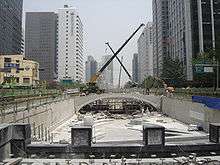

In July 2003, then-Seoul mayor, Lee Myung-bak initiated a project to remove the elevated highway and restore the stream. It was a major undertaking since the highway had to be removed and years of neglect and development had left the stream nearly dry. 120,000 tons of water were to be pumped in daily from the Han River, its tributaries, and groundwater from subway stations.[4] There were safety problems due to the deteriorated concrete. Still, restoration of Cheonggyecheon was deemed important as it fit in with the movement to re-introduce nature to the city and to promote a more eco-friendly urban design. Other goals of the project were to restore the history and culture of the region, which had been lost for 30 years, and to revitalize Seoul's economy.
The Seoul Metropolitan Government established several organizations to oversee the successful restoration of Cheonggyecheon: the Cheonggyecheon Restoration Project Headquarters for the control of the whole project; the Citizen's Committee for Cheonggyecheon Restoration Project for the management of conflict between the Seoul Metropolitan Government and the union of merchants; and the Cheonggyecheon Restoration Research Corps for the establishment and review of the restoration plan.
To address the consequent traffic problem, the Cheonggyecheon Restoration Project Headquarters established traffic flow measures in the downtown section affected by the restoration work and coordinated changes in the downtown traffic system based on the research of the Cheonggyecheon Restoration Research Corps.[3]
The restoration of two historic bridges, Gwangtonggyo and Supyogyo, was also a contentious issue, as several interest groups voiced opinions on how to restore historical and cultural sites and remains and whether to replace the bridges or not.[3]
The Cheonggyecheon restoration project had the purpose of preserving the unique identity of the natural environment and the historic resources in the CBD of Seoul, and to reinforce the surrounding business area with information technology, international affairs and digital industries.[3] The plan encouraged the return of the pedestrian-friendly road network connecting the stream with traditional resources: Bukchon, Daehangno, Jungdong, Namchon, and Donhwamungil. This network system, named the CCB (Cheonggyecheon Culture Belt), tried to build the cultural and environmental basis of the city.
Achievements
The stream was opened to the public in September 2005 and was lauded as a major success in urban renewal and beautification. However, there was considerable opposition from the previous mayoral administration of Goh Kun, which feared gentrification of the adjacent areas that housed many shops and small businesses in the machine trades.
Creating an environment with clean water and natural habitats was the most significant achievement of the project. Species of fish, birds, and insects have increased significantly as a result of the stream excavation.[5] The stream helps to cool down the temperature on the nearby areas by 3.6 °C on average versus other parts of Seoul.[6] The number of vehicles entering downtown Seoul has decreased by 2.3%, with an increasing number of users of buses (by 1.4%) and subways (by 4.3%: a daily average of 430,000 people) as a result of the demolition of the two heavily used roads.[7] This has a positive influence by improving the atmospheric environment in the region.
The project attempted to promote the urban economy through amplifying urban infrastructure for a competitive city in the business and industrial area centered on the stream. The urban renewal project was the catalyst of revitalization in downtown Seoul. Cheonggyecheon became a centre for cultural and economic activities.
Cheonggyecheon restoration work brought balance to the areas south and north of the stream. During the modernization era, downtown Seoul was divided into two parts, north-south, based on their features and function. The restoration helped to join these parts to create a new urban structure connecting the cultural and environmental resources in northern and southern areas of the stream (Hwang n.d.), resulting in a balanced and sustainable development of northern and southern areas of the Han River.
The project sped up traffic around the city when the motorway was removed. It has been cited as a real-life example of Braess' paradox.[8]
Cost
Budgeted at 349 billion won, the final cost of the project was over 386 billion won (approximately US$281 million).[3]
Some Korean environmental organizations have criticized its high costs and lack of ecological and historical authenticity, calling it purely symbolic and not truly beneficial to the city's eco-environment. Instead of using the restoration as an instrument of urban development the environmental organizations have called for a gradual long-term ecological and historical recovery of the entire Cheonggyecheon stream basin and its ecological system.[9]
The cost of managing Cheonggyecheon has been rising every year.[10]
Seoul Lantern Festival 2012 in Cheonggyecheon

Theme 1: The Seoul City Wall
The Seoul City Wall refers to the walls surrounding Hanyang, the capital of Joseon dynasty. The wall stretches for 18.6 km along the ridges of four mountains (Naesasan): Inwangsan, Bugaksan (formerly Baegaksan), Naksan, and Namsan. Four major gates were built around the ramparts: the east, west, south, and north. Additionally, four small gates were constructed between the four large ones.
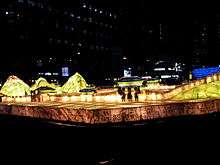
Theme 2: "The Ancestors Who Shaped the 600-year History of the Joseon Dynasty"
The Joseon Dynasty produced many long-lasting, rich cultural legacies throughout its 600-year period. In 1443, King Sejong the Great invented hangul, the most scientifically well-made language in the world. In 1446, the hunminjeongeum (literally the Correct/Proper Sounds for the Instruction of the People) was proclaimed, and it contained the principles behind the invention of hangul. The wisdom of Korean ancestors can be seen in their scientific instruments such as the honcheonui, which measured the movements and locations of celestial bodies, and jagyeongnu, a water clock that automatically marked the time.
Theme 3: "The Daily Lives of the People"
The long history of the Joseon Dynasty was enabled by wiminsasang, the ideology that rulers should respect the people. Examples of this idea in practice include the secret royal inspector system and the sinmungo, a drum that the common people would play whenever they suffered an injustice. The seasonal customs and daily lives of the people were similar to those of today, differing only in their forms and methods. The past forms the basis for the present, and the present builds the foundation for the future. In that sense, the daily lives of the Joseon era people serve as a portrait of our times as well.
Attractions and artwork
- Sungnyemun: Also known as Namdaemun, Sungnyemun is the south gate of the Joseon capital of Hanyang and has been designated as South Korea's No. 1 National Treasure. It was the oldest wooden building in Seoul before it was burned down in a 2008 fire. A restoration effort began in February 2010 and was complete by May 2013.

- Goblin Design: The goblin has been seen as something fearsome, yet simple-minded and familiar. This imaginary creature sometimes did harm to people and other times brought them riches. Their images are sometimes displayed at palaces and temples to ward off evil spirits.
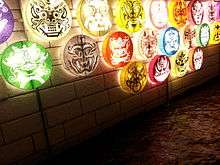
- Secret Dates Under the Moonlight: During the Joseon era, a couple could not enjoy a date at ease whether it was during the day or at night. People would instead secretly have dates in secluded areas under the bright moonlight.
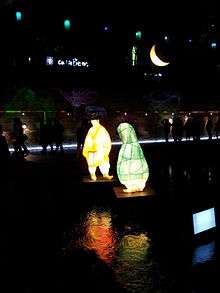
- Traditional Wedding: In a traditional wedding, the bride wears a headpiece or crown and wears red dots on the cheeks and forehead. Placed on top of the gyobaesang (table) are candlesticks, white rice cakes in the shape of a dragon, a hen, a flower vase made of pine tree, a flower vase made of bamboo, chestnuts, rice, jujubes, and other items. The bride and the groom bow to each other.
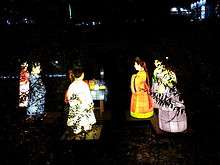
Videoclip
Photos
 A long park runs on both sides of the stream.
A long park runs on both sides of the stream.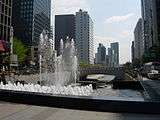 The beginning of the Cheonggye Stream
The beginning of the Cheonggye Stream.jpg) Cheonggye Stream flowing through Seoul
Cheonggye Stream flowing through Seoul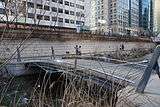 Cheonggye Stream in winter
Cheonggye Stream in winter The beginning of the Cheonggye Stream at night
The beginning of the Cheonggye Stream at night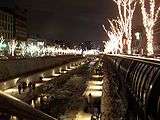 The Cheonggye Stream at night
The Cheonggye Stream at night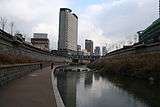 The Cheonggye Stream east of Dongdaemun Market
The Cheonggye Stream east of Dongdaemun Market Live entertainment on Cheonggye Stream near Dongdaemun Market
Live entertainment on Cheonggye Stream near Dongdaemun Market- Cheonggyecheon around Mojeongyo
- Coosje van Bruggen and Claes Oldenburg, spring (2006)
See also
Notes
- 1 2 2013년 한국하천일람 [List of Rivers of South Korea, 2013] (PDF) (in Korean). Han River Flood Control Office, Republic of Korea. 31 December 2012. pp. 108–109. Retrieved 8 July 2014.
- ↑ PDF, in Korean. Retrieved on 2010-11-21.
- 1 2 3 4 5 6 Official website of Cheonggyecheon, Retrieved on 2010-11-21.
- ↑
- Park, Kil-dong. (2007). Cheonggyecheon Restoration Project Archived July 17, 2011, at the Wayback Machine..
- ↑ Urban waterways: Seoul peels back the pavement and reveals a river - Cheonggyecheon, Livable cities, Seoul | TerraPass: Fight global warming, reduce your carbon footprint Archived August 2, 2009, at the Wayback Machine.. TerraPass (2009-07-17). Retrieved on 2010-11-21.
- ↑ donga.com[English donga]. English.donga.com (2005-08-12). Retrieved on 2010-11-21.
- ↑
- ↑ Easley, D and Kleinberg, J: "Networks", page 71. Cornell Store Press, 2008
- ↑ Cho, Myun-Rae. (2010). "The Politics of Urban Nature Restoration".
- ↑ Kang (강), Gyeong-ji (경지) (2011-11-20). 청계천 물길 따라 해마다 80억원 증발. edaily (in Korean). Retrieved 2011-12-03.
Further reading
- M.-R. Cho, "The Politics of Urban Nature Restoration, The Case of Cheonggyecheon Restoration in Seoul, Korea," International Development Planning Review, Vol. 32, No. 2, 2010.
- J. H. Shin, "Dream and Hope of Korea, Cheonggyecheon Restoration," Magazine of Korean Water Resources Association, Vol. 37, No. 1, 2004.
- B. Križnik, "Urban Regeneration in Global Seoul: New Approaches, Old Divides?" Wiener Beiträge zur Koreaforschung, Vol. 2, No. 1, 2010.
External links
| Wikimedia Commons has media related to Cheonggyecheon. |
- Cheonggyecheon Seoul Metropolitan Facilities Management Coroporation
- Cheonggyecheon Official Seoul City Tourism Website
Coordinates: 37°34′12″N 127°0′23″E / 37.57000°N 127.00639°E